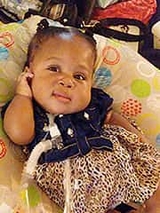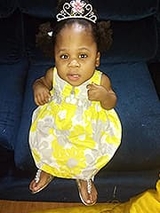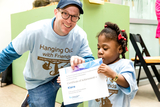Skeletal Dysplasia, Thoracic Insufficiency and Pulmonary Hypoplasia: Klaire’s Story
Skeletal Dysplasia, Thoracic Insufficiency and Pulmonary Hypoplasia: Klaire’s Story
Klaire was able to breathe for 18½ hours on her own after birth. But her lungs were too small and weak to get her bloodstream enough oxygen. Over the next few years, Klaire and her mother would find the care and support they needed at Children’s Hospital of Philadelphia (CHOP).

Klaire has a big personality. She sings and dances; she’s considered the mayor of her school; and whether it’s through gestures or her very expressive eyes, she always lets you know what she’s thinking.
She has a lot of “Klaire-isms,” as her mother, Diemmah, puts it. Whether it’s giving you the eye if you try and turn off Barney or getting on your lap and rubbing your back when she knows you’re sad, every person who has met Klaire has been touched by her unique personality and loving heart.
But while Klaire is thriving now, it wasn’t always clear if she would get the chance to flourish.
An uncertain time
Diemmah wasn’t sure what to think. She was 4 months into her pregnancy with her second child and her doctor had informed her that her baby wasn’t growing fast enough. He gave her a bleak outlook and Diemmah feared that she’d never get to meet the little one inside her.
She decided to get a second opinion at the Hospital of the University of Pennsylvania. The doctors there were much more optimistic. They let Diemmah know that she had more options available to her than she realized and referred her to the Children’s Hospital of Philadelphia (CHOP).
A hundred questions from a multitude of diagnoses

After weeks of being watched closely by CHOP specialists, Diemmah gave birth to Klaire on July 5th. Klaire was able to breathe on her own for 18½ hours but then started to struggle. She was dealing with skeletal dysplasia and thoracic insufficiency syndrome. One result was that her chest didn’t have enough room for her lungs and other organs. Her lungs were just too small (pulmonary hypoplasia) and not quite strong enough to get the necessary oxygen to her bloodstream. Klaire needed to be intubated.
Klaire would stay in the NICU for 39 days. During this time she would have two surgeries: a tracheostomy and getting a gastronomy tube placed. Diemmah remembers this time being filled with a lot of emotion. Overwhelming love for this beautiful baby, worry for her wellbeing, and anxiety over what would happen next.
Diemmah says that “anyone in this position would feel that way, but the best part about it was being at CHOP. They let us stay there the entire time. The nurses were great, and the doctors were wonderful.”
There were a lot of questions at every turn but there was always an answer. Diemmah says, “If I had a hundred questions, they would answer every one of them.”
Time for VEPTR surgery to treat thoracic insufficiency syndrome
Klaire went home at 4 months old and settled into a rhythm with her family. She had regular check-ups with her doctors in the Wyss/Campbell Center for Thoracic Insufficiency Syndrome (CTIS) to closely monitor her development. Based on Klaire’s progress, Patrick Cahill, MD recommended that she undergo surgery to receive a VEPTR implant.
VEPTR, or vertical expandable prosthetic titanium rib, is the first FDA-approved device for the treatment of thoracic insufficiency syndrome, created by experts at CHOP. This implant is placed inside a child’s ribcage and can help to surgically expand their chest cavity, allowing for proper lung growth and correcting spinal deformities.
Diemmah agreed and felt a mixture of worry and optimism as Klaire headed in for her surgery. Thinking she had a little time, Diemmah went home to quickly shower and by the time she returned, Klaire was already out of surgery!
“You could see the relief in her, Diemmah says. “Like she wasn’t just lying there, she wasn’t just existing. She was starting to move; she was starting to do more than just respond with her eyes.”
Klaire would return to CHOP every 6-8 months to have her VEPTRs expanded so she could continue to grow.
A certain kind of sunshine

Dr. Cahill and the other CTIS specialists continued to monitor Klaire as she grew. Over the past two years, her pulmonary status has improved so much and she’s doing so well that she no longer needs VEPTR expansions. In fact, she was able to have her VEPTRs removed, no longer needs a ventilator, and was successfully decannulated to remove her breathing tube and tracheotomy.
In May 2023, Klaire and her family attended the Wyss/Campbell Center for Thoracic Insufficiency Syndrome (CTIS) Reunion at the Philadelphia Zoo. While gathering with fellow patients, new friends and families, Klaire was awarded a special certificate of achievement for “graduating” from the CTIS.
Now 6 years old, Klaire is focusing on all the important things that any child should: singing, dancing, playing and is beginning to show interest in learning how to read. The recent kindergarten graduate is looking forward to summer, time off and launching into first grade in the fall.

For now, Klaire’s family is focused on making every day meaningful for her. Diemmah radiates so much love when talking about her daughter, adding: “This little girl would warm the coldest heart. She creates a certain kind of sunshine for everybody.”